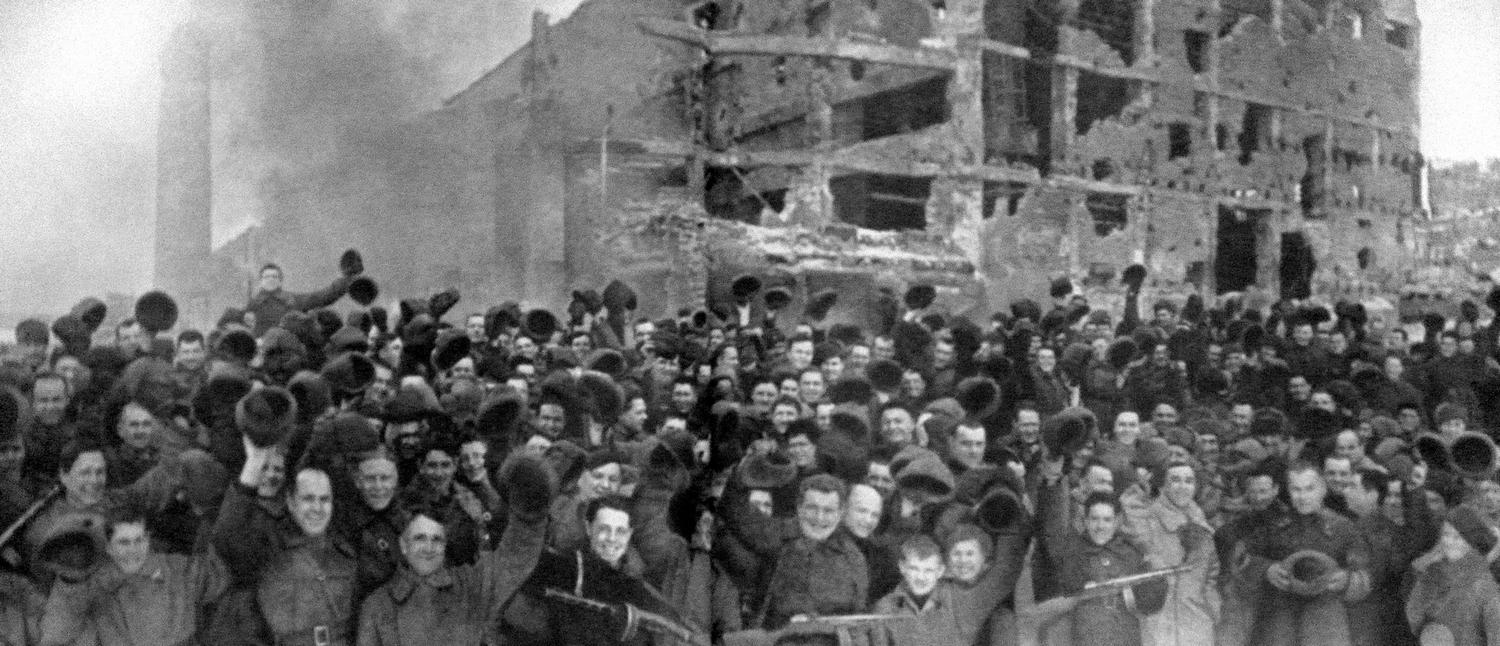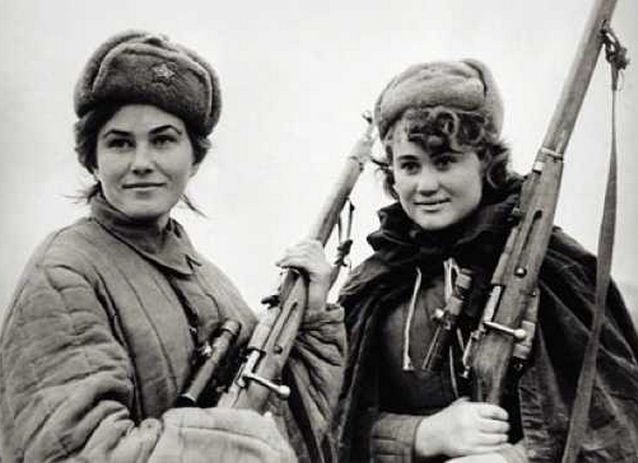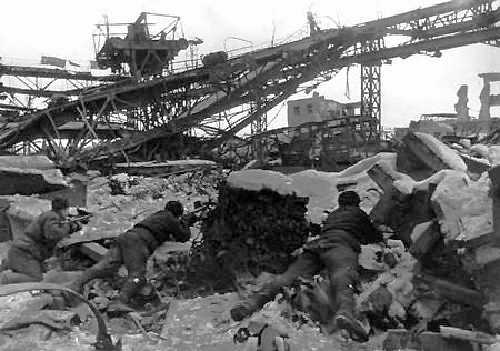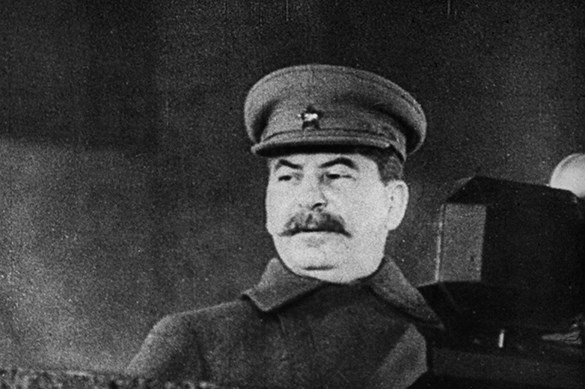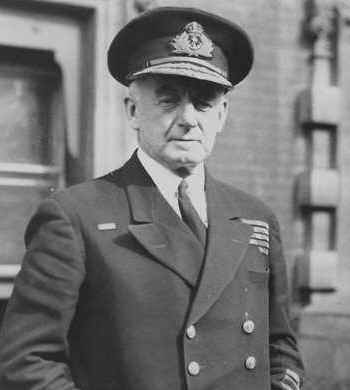
|
January 27, 2018 - No. 3 75th Anniversary of Victory of the Battle of Stalingrad All Glory to Those
Whose Heroism
• Importance
of Discussion on Significance of the Victory 75th Anniversary of Victory of the Battle of Stalingrad All Glory to Those Whose Heroism Defended Stalingrad and Changed the Course of World War II
On the occasion of the 75th anniversary of the victory of the Battle of Stalingrad on February 2, 1943, the Communist Party of Canada (Marxist-Leninist) sends its heartfelt congratulations to all the descendants of those who fought and defeated the Nazi invaders who attacked Stalingrad on August 23, 1942. The battle concluded with the encirclement and surrender of a German army of 300,000 troops. This dealt a crushing blow to the Nazi Wehrmacht. Followed by a decisive victory at Kursk, the victory of the Battle of Stalingrad began a powerful counteroffensive that drove the Hitlerites steadily back from whence they came, until the final demise of the Third Reich in Berlin in May 1945. The battle changed the course of WWII in favour of the Soviet peoples and the peoples of Europe and the world. Speaking in November 1943 at the celebration of the 26th anniversary of the Great October Revolution, Joseph Stalin assessed the battle as follows:
The battle of Stalingrad ended in the encirclement of a German Army 300,000 strong, its rout and the capture of about one-third of the encircled troops. To form an idea of the scale of the slaughter, unparalleled in history, which took place on the battlefields of Stalingrad, one must realize that after the battle of Stalingrad was over, 147,200 bodies of killed German officers and men and 46,700 bodies of killed Soviet officers and men were found and buried. Stalingrad signified the decline of the German-fascist army. After the Stalingrad slaughter, as is known, the Germans were unable to recover. [...] All the peoples of the Soviet Union have risen as one in defence of their Motherland, rightly regarding the present Patriotic War as the common cause of all working people irrespective of nationality or religion. By now the Hitlerite politicians themselves see how hopelessly stupid were their calculations on discord and conflict among the peoples of the Soviet Union. The friendship of the peoples of our country has withstood all the hardship and trials of the war and has become tempered still further in the common struggle of all Soviet people against the fascist invaders. Herein lies the source of the strength of the Soviet Union. (Loud and prolonged applause.) As in the years of peaceful construction, so in the days of war, the leading and guiding force of the Soviet people has been the Party of Lenin, the Party of the Bolsheviks. No other Party has ever enjoyed, or enjoys, such prestige among the masses of the people as our Bolshevik Party. And this is natural. Under the leadership of the Bolshevik Party, the workers, peasants and intelligentsia of our country have won their freedom and built a Socialist society. In the Patriotic War the Party has stood before us as the inspirer and organizer of the nation-wide struggle against the fascist invaders. The organizational work of the Party has united and directed all the efforts of the Soviet people towards the common goal, subordinating all our forces and means to the cause of defeating the enemy. During the war, the Party has increased its kinship with the people, has established still closer links with the broad masses of the working people. Herein lies the source of the strength of our state. (Loud and prolonged applause.)
The victory shows many things, from the depths of Nazi brutality and barbarity -- as well as arrogance and vainglory -- to the heights of Soviet bravery, heroism and innovation. But, perhaps above all else, the affirmation of Stalingrad's right to be in the face of Nazi aggression required the organization of a new kind which had been created in the Soviet Union in the form of the communist party of a new type and Soviet Power. The battle revealed the new quality of organization and resistance that emerged in war conditions as a result of Soviet Power, where the people and their communist leadership became one to realize the justice of their cause. The aim, determination and the expression of their motivation can be seen in their deeds as they rose to defend their city, their Soviet motherland and workers' state.
Today, too, in the new historical conditions, establishing an aim and the organization capable of realizing that aim are crucial to turn things around in the peoples' favour. To avert the dangers which lie ahead, peoples saddled with old forms of representation require new forms of organization in the form of anti-war governments where it is the people who take decisions in their own name. No longer will they hand over their decision-making power to others who act in their name but then betray the people's interests. Far from it, the peoples' so-called sovereign representatives represent a fictitious person of state who rules over the people to advance private interests, not those established by the people themselves. The form of rule and the form of leadership must be consistent with the requirements of the new historical conditions which have emerged in the last 30 years since the fall of the former Soviet Union. The forms used in the past, which was a period of flow of revolution, were consistent with a situation which required the containment and eradication of Nazi-fascism, come what may, to safeguard the future of humankind. That was a period when the peoples of the world had the great Soviet Union on their side to spearhead the battle for victory and inspire the peoples of the entire world to do likewise. But today the revolution is in retreat. The imperialists and reactionary forces have the initiative, not the peoples of the world. These counter-revolutionary forces have formed international cartels and coalitions comprised of powerful private interests that collude and contend for control of the world's resources and spheres of influence as well as the power to be sole decision-makers on a supranational basis. Whatever they cannot control they seek to destroy, as in the case of invasions of sovereign nations and untold crimes against humanity, which surpass even those of the Hitlerites in scale and brutality. All of this is carried out under the guise that they uphold the cause of freedom, democracy and peace -- the very things the peoples of the world fought for in World War II and made the supreme sacrifice to achieve. Today, as we celebrate the victories of the past, it is necessary to discuss the significance of the victory of the Battle of Stalingrad so as to enable the peoples to turn the tide of counter-revolution which assails the peoples of the world at this time. The peoples need to seize the initiative and turn things around in their favour. The opposition of the peoples of the world to the neo-liberal counter-revolution and its attendant wars of aggression and crimes against humanity must be strengthened. From acts of resistance, a mighty force must emerge that is capable of ending the barbaric rule of the present-day rulers. This issue of TML Weekly pays homage to the heroism of the defenders of Stalingrad and their leadership on the occasion of their glorious victory at Stalingrad. Click here for the calendar of events taking place in Canada on this occasion.
Importance of Discussion on
|
|
|
[...] From the purely military point of view, the defeat of the German troops on our front by the close of this year was predetermined by two major events: the Battle of Stalingrad and the Battle of Kursk. The Battle of Stalingrad ended in the encirclement of a German Army 300,000 strong, its rout and the capture of about one-third of the encircled troops. To form an idea of the scale of the slaughter, unparalleled in history, which took place on the battlefields of Stalingrad, one must realize that after the Battle of Stalingrad was over, 147,200 bodies of killed German officers and men and 46,700 bodies of killed Soviet officers and men were found and buried. Stalingrad signified the decline of the German-fascist army. After the Stalingrad slaughter, as is known, the Germans were unable to recover.
As for the Battle of Kursk, it ended in the rout of the two main groups of the attacking German-fascist troops, and in our troops passing over to a counteroffensive, which subsequently turned into the powerful Red Army summer offensive. The Battle of Kursk began with the German offensive against Kursk from the north and south. This was the last attempt of the Germans to carry out a big summer offensive and, in the event of its success, to recoup their losses.
As is well known, the offensive ended in failure, the Red Army not only repulsed the German offensive, but itself passed over to the offensive and, by a series of consecutive blows, in the course of the summer period hurled the German-fascist troops back beyond the Dnieper.
While the Battle of Stalingrad heralded the decline of the German-fascist army, the Battle of Kursk confronted it with disaster. Finally, this year marked a turning-point because the successful Red Army offensive radically aggravated the economic and military political situation of fascist Germany, and confronted her with a profound crisis.
The Germans counted on carrying out in the summer of this year a successful offensive on the Soviet-German front, to redeem their losses and to bolster up their shaken prestige in Europe. But the Red Army upset the Germans' calculations, repulsed their offensive, itself launched an offensive and proceeded to drive the Germans westwards, thereby shattering the prestige of German arms.
The Germans counted on prolonging the war, started building defence lines and "walls," and proclaimed for all to hear that their new positions were impregnable. But here again the Red Army upset the calculations of the Germans, broke through their defence lines and "walls," and continued successfully to advance, giving them no time to drag out the war.
The Germans counted on rectifying the situation at the front by means of "total" mobilization. But here, too, events upset the Germans' calculations. The summer campaign has already eaten up two-thirds of the "totally" mobilized. However, it does not look as if this circumstance has brought about any improvement in the position of the German-fascist army. It may prove necessary to proclaim yet another "total" mobilization, and there is no reason why a repetition of such a measure should not result in the "total" collapse of a certain state. (Loud applause.) The Germans counted on retaining a firm hold on the Ukraine in order to avail themselves of Ukrainian agricultural produce for their army and population, and of Donbas coal for the factories and railways serving the German army. But here, too, they miscalculated. As a result of the successful Red Army offensive the Germans lost not only the Donbas coal, but also the richest grain-producing regions of the Ukraine, and there is no reason to suppose that they will not also lose the rest of the Ukraine in the very near future. (Loud applause.) Naturally, all these miscalculations could not but worsen, and in fact did radically worsen, the economic and military-political position of fascist Germany. Fascist Germany is passing through a profound crisis. She is facing disaster.
II. Nation-Wide Assistance to the Front
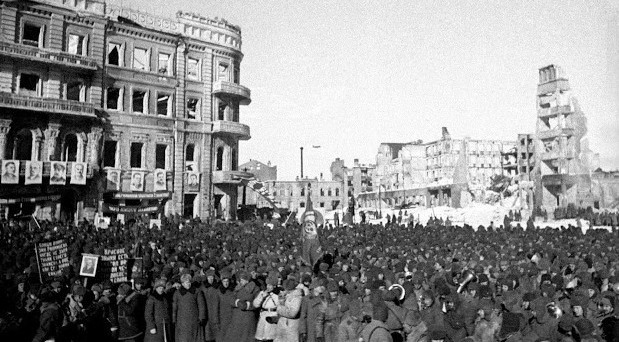
Mass celebrations in Stalingrad following the hard won victory over
the German fascist army,
February 2, 1943.
The successes of the Red Army would have been impossible without the support of the people, without the self-sacrificing work of the Soviet people in the factories and workshops, collieries and mines, transport and agriculture. In the hard conditions of war the Soviet people have proved able to ensure for their Army everything at all necessary and have incessantly perfected its fighting equipment. Never during the whole course of the war has the enemy been able to surpass our Army in quality of armaments. At the same time our industry has given the front ever-increasing quantities of war equipment.
The past year marked a turning-point not only in the trend of military operations but also in the work of our home front. We were no longer confronted with such tasks as the evacuation of enterprises to the east and the switching of industry to production of armaments. The Soviet State now has an efficient and rapidly expanding war economy. Thus all the efforts of the people could be concentrated on increase of production and further improvement of armaments, particularly tanks, planes, guns and self-propelled artillery. Here we achieved big successes. The Red Army, supported by the entire people, has received uninterrupted supplies of fighting equipment, rained millions of bombs, mines and shells upon the enemy and brought thousands of tanks and planes into battle. One has every ground for saying that the self-sacrificing labour of the Soviet people in the rear will go down in history side by side with the Red Army's heroic struggle and the unparalleled feat of the people in defence of their Motherland. (Prolonged applause.)
Workers of the Soviet Union, who in the years of peaceful construction built up our highly developed, powerful socialist industry, have during the Patriotic War been working with intense zeal and energy to help the front, displaying true labour heroism. Everyone knows that in the war against the USSR, the Hitlerites had at their disposal not only the highly developed industry of Germany, but also the rather powerful industries of the vassal and occupied countries. Yet the Hitlerites have failed to maintain the quantitative superiority in military equipment which they had at the beginning of the war against the Soviet Union. If the former superiority of the enemy as regards number of tanks, planes, mortars and automatic rifles has now been liquidated, if our army today experiences no serious shortage of arms, ammunition and equipment, the credit for this is due, in the first place, to our working class. (Loud and prolonged applause.)
The peasants of the Soviet Union, who in the years of peaceful construction on the basis of the collective farm system transformed a backward agriculture into an advanced agriculture, have displayed during the Patriotic War a high degree of awareness of the common national interest unparalleled in the history of the country-side. By self-sacrificing labour to help the front, they have shown that the Soviet peasantry considers the present war against the Germans to be its own cause, a war for its own life and liberty.
It is well known that as a result of invasion by the fascist hordes, our country was temporarily deprived of the important agricultural districts of the Ukraine, the Don and the Kuban. And yet our collective and State farms supplied the army and the country with food without any serious interruptions. Of course, without the collective farm system, without the self-sacrificing labour of the men and women collective farmers, we, could not have coped with this most difficult task. If in the third year of the war our army is not experiencing a shortage of food, and if the population is supplied with food and industry with raw materials, this is evidence of the strength and vitality of the collective farm system, of the patriotism of the collective farm peasantry. (Prolonged applause.)
A great part in helping the front has been played by our transport, primarily by railway transport, and also by river, sea and motor transport. As is known, transport is the vital means of connecting the rear and the front. One may produce large quantities of arms and ammunition, but if transport does not deliver them to the front on time they may remain useless freight as far as the front is concerned. It must be said that transport plays a decisive part in the timely delivery of arms and ammunition, food, clothing and so on to the front. If in spite of war-time difficulties and a shortage of fuel, we have been able to supply the front with everything necessary, the credit goes in the first place to our transport workers and office employees. (Prolonged applause.)
Nor does our intelligentsia lag behind the working class and peasantry in their aid to the front. The Soviet intelligentsia is working with devotion for the defence of our country, continually improving the Red Army's armaments and the technology and organization of production. It helps the workers and collective farmers to improve industry and agriculture, advances Soviet science and culture in the conditions of war. This is to the honour of our intelligentsia. (Prolonged applause.)
All the peoples of the Soviet Union have risen as one in defence of their Motherland, rightly regarding the present Patriotic War as the common cause of all working people irrespective of nationality or religion. By now the Hitlerite politicians themselves see how hopelessly stupid were their calculations on discord and conflict among the peoples of the Soviet Union. The friendship of the peoples of our country has withstood all the hardship and trials of the war and has become tempered still further in the common struggle of all Soviet people against the fascist invaders. Herein lies the source of the strength of the Soviet Union. (Loud and prolonged applause.)
As in the years of peaceful construction, so in the days of war, the leading and guiding force of the Soviet people has been the Party of Lenin, the Party of the Bolsheviks. No other Party has ever enjoyed, or enjoys, such prestige among the masses of the people as our Bolshevik Party. And this is natural. Under the leadership of the Bolshevik Party, the workers, peasants and intelligentsia of our country have won their freedom and built a Socialist society. In the Patriotic War the Party has stood before us as the inspirer and organizer of the nation-wide struggle against the fascist invaders. The organizational work of the Party has united and directed all the efforts of the Soviet people towards the common goal, subordinating all our forces and means to the cause of defeating the enemy. During the war, the Party has increased its kinship with the people, has established still closer links with the wide masses of the working people. Herein lies the source of the strength of our state. (Loud and prolonged applause.)
The present war has forcefully confirmed the well-known statement of Lenin to the effect that war is an all-round test of a nation's material and spiritual forces. The history of war teaches that only those states withstood this test which proved stronger than their adversaries as regards the development and organization of their economy, as regards the experience, skill and fighting spirit of their troops, as regards the fortitude and unity of the people throughout the whole course of the war. Ours is just such a State.
The Soviet State was never so stable and unshakable as now, in the third year of the Patriotic War. The lessons of the war show that the Soviet system is not only the best form of organizing the economic and cultural development of the country in the years of peaceful construction, but also the best form of mobilizing all the forces of the people for resistance to the enemy in war time. Soviet power, established 26 years ago, has transformed our country within a short historical period into an impregnable fortress. The Red Army has the most stable and reliable rear of all the armies in the world. Herein lies the source of the strength of the Soviet Union. (Loud and prolonged applause.) [...]
Brief History
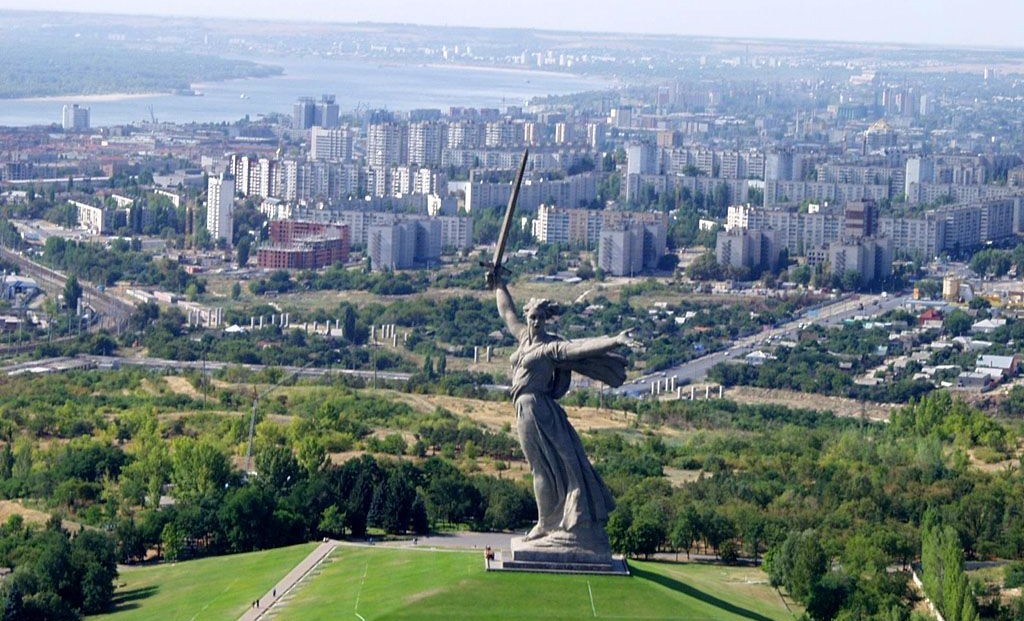
View of Stalingrad today (renamed
Volgograd in 1961),
with the memorial complex
commemorating the Battle of Stalingrad in the foreground. Stalingrad
was reconstructed
at
record speed after its destruction by the Nazis.
Background on Stalingrad
The city that came to be known as Stalingrad was founded in 1589 as Tsaritsyn, named for the Russian tsars. As a significant city and port, it was fought over by the Bolshevik forces and the White Army from 1918 to 1920 during the Russian Civil War. In honour of J.V. Stalin's role in leading the Bolshevik forces to victory there, it was renamed Stalingrad in 1925. Following the civil war, the city was developed into a major centre of heavy industry, becoming a rail transport hub in addition to a port. This was part of the Soviet program to industrialize the USSR to not only improve the economy, but to ensure it had the means to defend itself from foreign military aggression. As such, Stalingrad had great military and strategic significance.
Axis Powers Launch Operation Barbarossa, June 22, 1941
The Nazis and their European allies launched Operation
Barbarossa to invade the Soviet Union on June 22, 1941, with nearly
four million troops divided into Army
Groups North, Centre and South. Army Group North's role was
the capture of Leningrad and Army Group Centre's role the capture
of Moscow. Army Group South's goal was the occupation of Ukraine
and the Caucasus to deprive the Soviet peoples of major
agricultural lands and oil production, and from there proceeding
eastward to Stalingrad.

Operation Barbarossa included Operation Typhoon, launched October 2, 1941 using Army Group Centre to capture Moscow, which was halted before reaching the city due to winter conditions and lack of supplies. The Red Army counterattacked on December 5, 1941, resulting in the first major German retreat of World War II. Operation Barbarossa's failure to quickly defeat the Soviets with blitzkrieg warfare meant that future German operations were more limited.
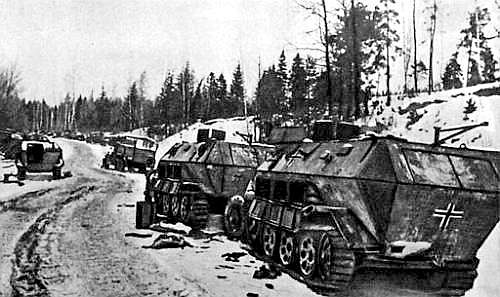
German armour involved in Operation Typhoon halted in snow.

Red Army heads to counterattack German forces around Moscow, December
1941.
Case Blue (Operation Braunschweig), June 28, 1942
A summer operation launched on June 28, 1942,
Case Blue (Operation Braunschweig) was intended to capture the oil
fields and agricultural lands of the
Caucasus to supply the German army
after the British military instituted a naval blockade stopping
supplies from the Americas. The Germans targetted the oilfields of
Baku, Maykop
and Grozny, which produced over 80 per cent of Soviet oil
(marked A on the map), while attacks on Voronezh (B) and
Stalingrad (C) were to protect their northern flanks.
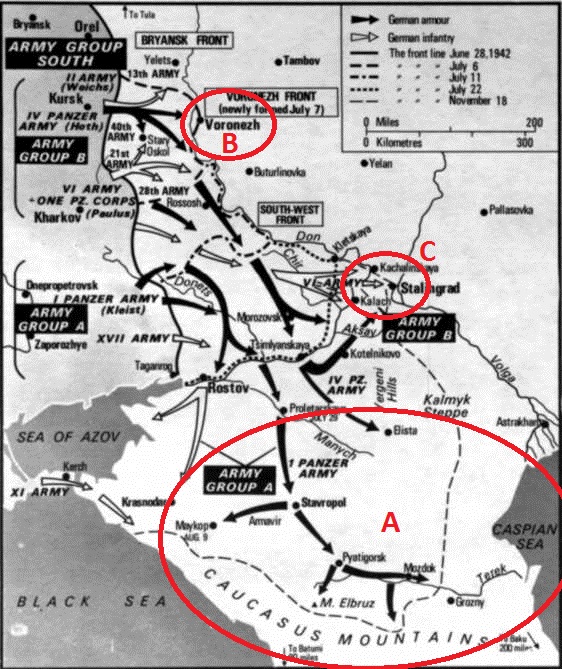
July 20 to August 8, 1942
On July 20, 1942, the German Sixth Army attacked the Soviet 62nd and 64th Armies, nearly encircling them by August 8, 1942. The Soviet forces were able to prevent themselves from being cut off and fell back to defensive positions around Stalingrad.
Battle of Stalingrad Begins, August 23, 1942
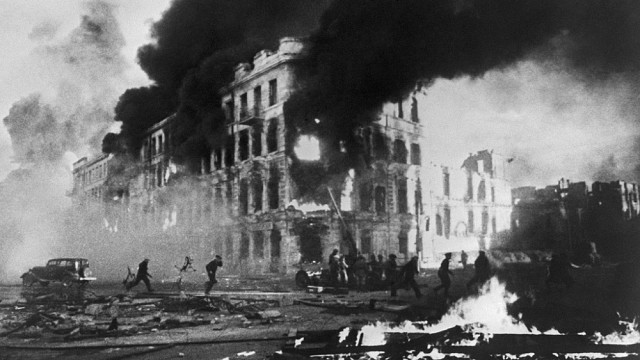
Bombing of Stalingrad, August 23, 1942
The Germans began their assault on Stalingrad on August 23, 1942, with a massive air raid at 4:00 pm, involving over 1,000 aircraft. Forty thousand civilians were killed in that raid alone.
Soviet losses were very heavy, but the Soviet military
and
political leadership issued the "Not One Step Backwards" order that
prevented total collapse.

Remnants of the Children's Khovorod fountain against a background of
flaming buildings is one of the best known images of the destructive
German
air raid that killed 40,000 civilians.
War of the Rats, September 12 to November 19, 1942

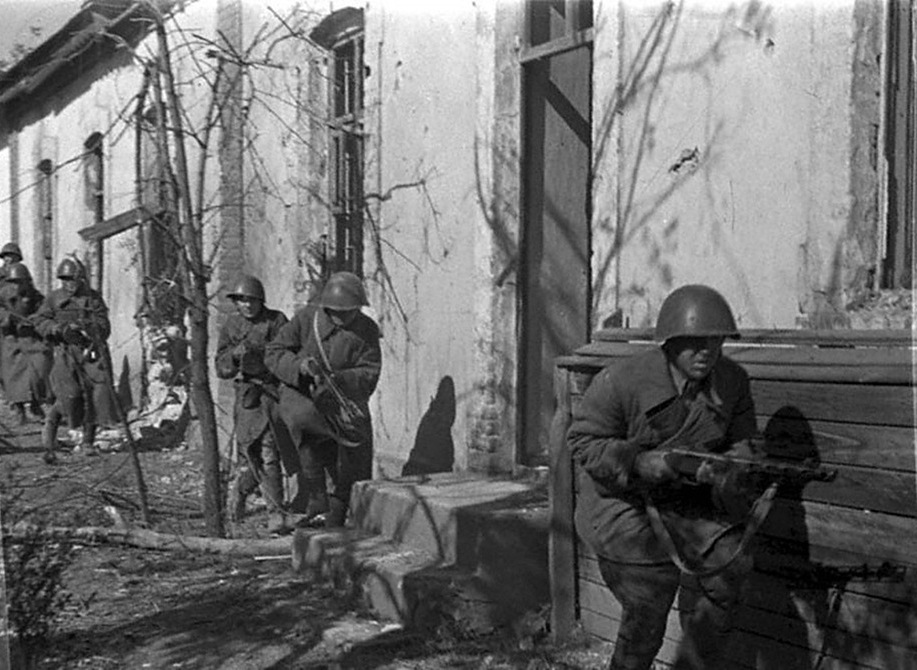
Red Army troops engaged in house-to-house combat that typified
the "War of the Rats" and wore down the German army in Stalingrad.
This most intense period of the Battle of Stalingrad
began in mid-September 1942. The bitter combat was referred to by the
Germans as the Rattenkrieg (War of the Rats). General Vasily Chuikov
was appointed to lead the 62nd Army, which had less than 100 tanks and
20,000 ill-trained troops, against an Axis force of over 100,000
well-trained men. To counter the Germans' air superiority, he kept the
front line within 50 metres of them and had snipers in all key
positions. He ordered hand-to-hand street fighting to wear down the
attackers, which restricted the German use of armoured vehicles and
artillery strikes. Thus the infamous German blitzkrieg tactics were
rendered useless.
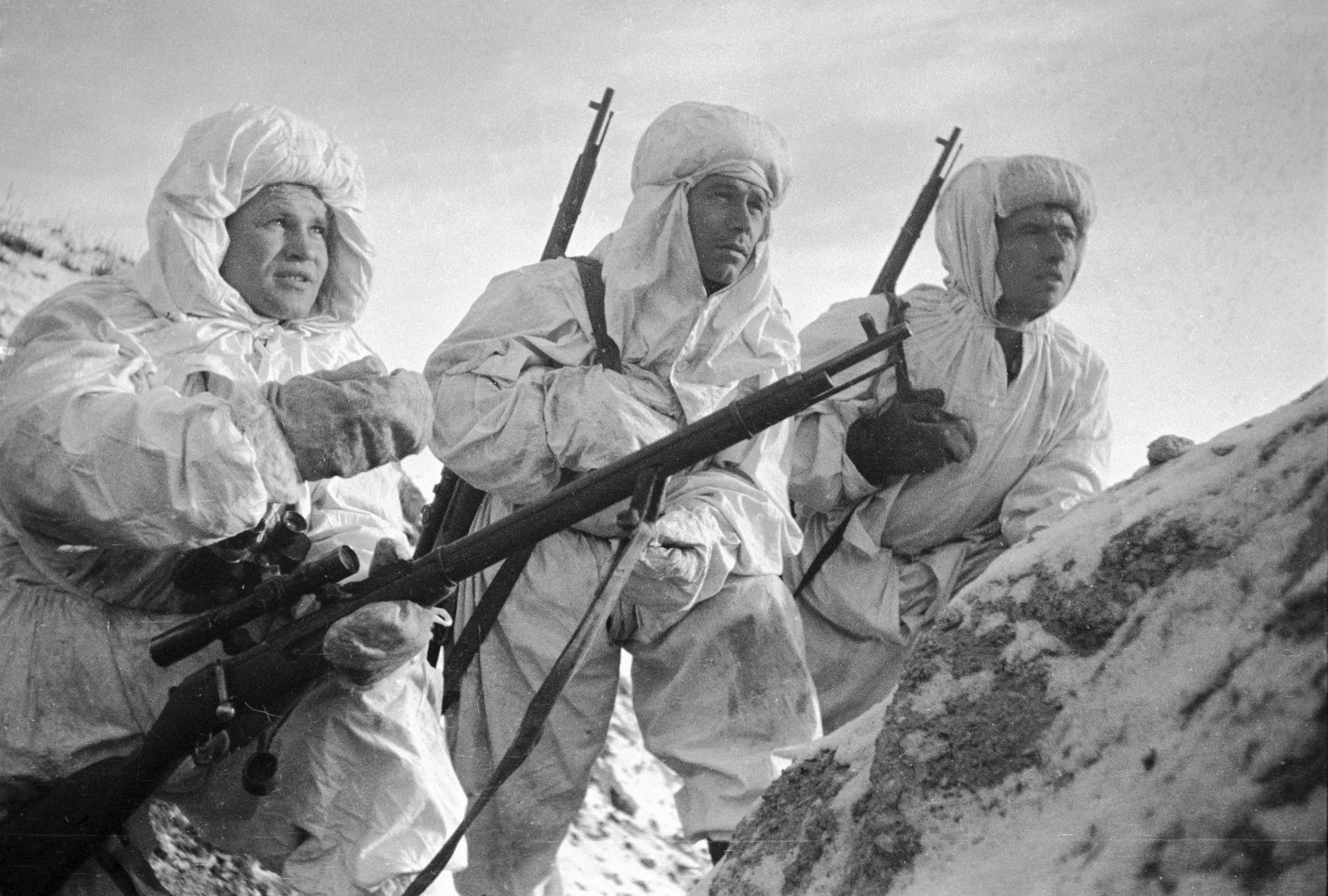
Vasily Zaitsev (left) and fellow snipers in winter camouflage in
Stalingrad, pioneered various sniper tactics during the battle.
They were very effective in killing German officers, which in turn
greatly demoralized the German troops.
Though the Germans captured about 90 per cent of
Stalingrad,
and the front line was 180 metres from the Volga River, the Soviet
defence was kept alive by the constant ferrying of reinforcements
across the river, as well as the dogged tenacity and heroism of
the Red Army and the people of Stalingrad themselves. Among the
most famous examples of this resistance was that of the 42nd Platoon
led by Sergeant
Yakov Pavlov, who fortified themselves in a four-story building and
held off multiple daily assaults by the Germany Army for 60 days,
from September 27 to November 25, 1942, before being relieved and
the Germans pushed back. The building, later known as Pavlov's
House, enabled the Red Army to defend a key section of the Volga
River.
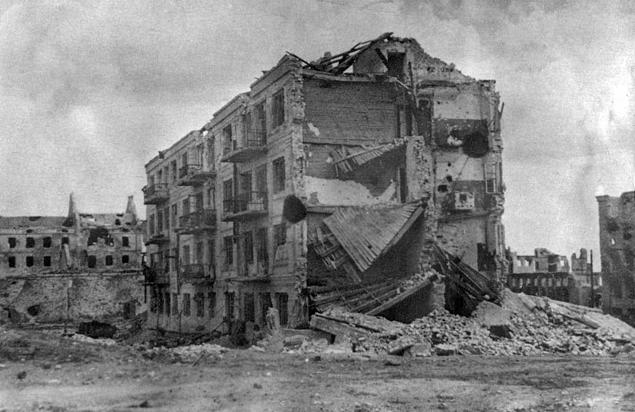
Pavlov's House during the Battle of Stalingrad.
Soviet Counteroffensive, Operation Uranus, November 19-22, 1942
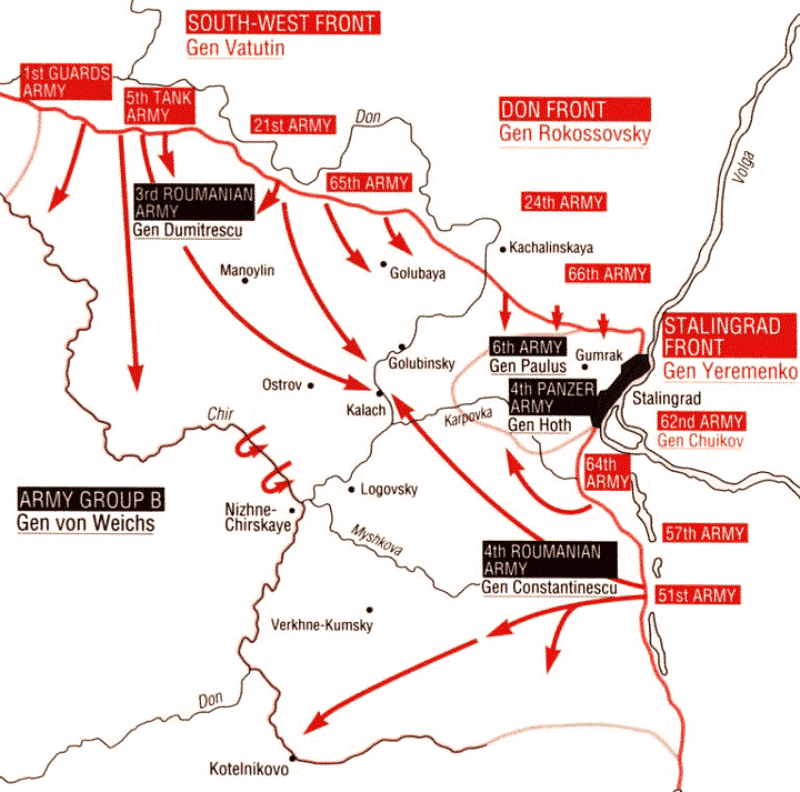
Soviet counteroffensive "Operation Uranus" traps the German Sixth Army
in
Stalingrad
from November 1942 until their defeat in February 1943.
Marshals Georgy Zhukov and Aleksandr Vasilevsky had been
planning
Operation
Uranus in absolute secrecy since September 12, 1942. Their aim was to
lure the Germans into pouring in more resources
to capture Stalingrad by maintaining the 62nd Army's defences at a
minimal level and then attack the German flanks. Operation
Uranus involved over 1.5 million troops. It took advantage of the
more poorly equipped Romanian troops defending the German flanks and
poor winterization of the
Axis forces, ultimately encircling 22 divisions. More than a
quarter million German troops were trapped inside the Stalingrad
pocket, referred to by the Germans as the Kessel
(cauldron).

Soviet tanks northwest of Stalingrad advance toward the city as part
of Operation Uranus.
November 23 to December 12, 1942
Hitler forbade his generals to attempt a breakout and promised an air bridge of supplies, after assurances by the head of the Luftwaffe Hermann Goering that this was possible. On the best day of the airlift, the encircled troops were still short of 150 tons of supplies. Despite protests from generals such as Walther von Seydlitz, General Friedrich Paulus, the commander of the German Sixth Army, lacked the moral courage to defy Hitler and attempt a breakout.
German Relief Attempt, Operation Winter Storm, December 12-22, 1942

Operation Winter Storm was launched by German Field Marshal Erich von Manstein of Army Group Don, to relieve the German forces in Stalingrad. The attack came within 160 kilometres of Stalingrad, but was halted due to bad weather and the inability of the Sixth Army to link up. The Soviets had also launched Operation Little Saturn on December 16, 1942, which threatened to encircle von Manstein's forces.
Soviet Counteroffensive, Operation Little Saturn,
December 15, 1942 to January 8, 1943
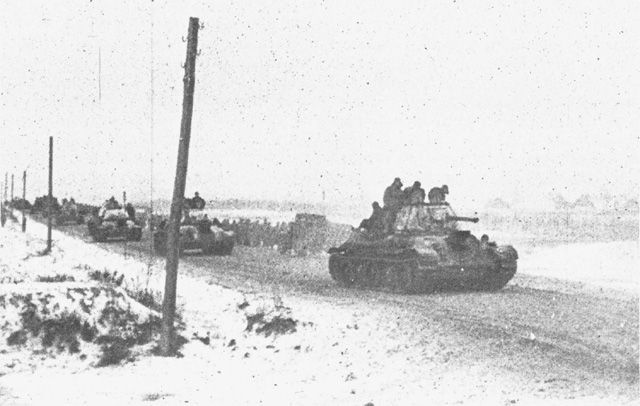
Soviet troops take part in Operation Little Saturn.
The Soviets' Operation Little Saturn was a modified version of Operation Saturn. The initial plan of Operation Saturn was to increase the area controlled by the Soviet Army to Rostov and Kharkov, but it had to be scaled back with the launch of the Germans' Operation Winter Storm on December 12, 1942. Operation Little Saturn succeeded in forcing von Manstein's forces to retreat, leaving the encircled German Sixth Army in Stalingrad on their own.
Soviets Extend Offer of Truce, January 9, 1943
Soviet General Rokossovsky sent three truce envoys to German lines to convince General Paulus to give the surrender of the Sixth Army, guaranteeing fair treatment of prisoners. Their offer was turned down, under orders from Hitler.
January 10 to February 2, 1943
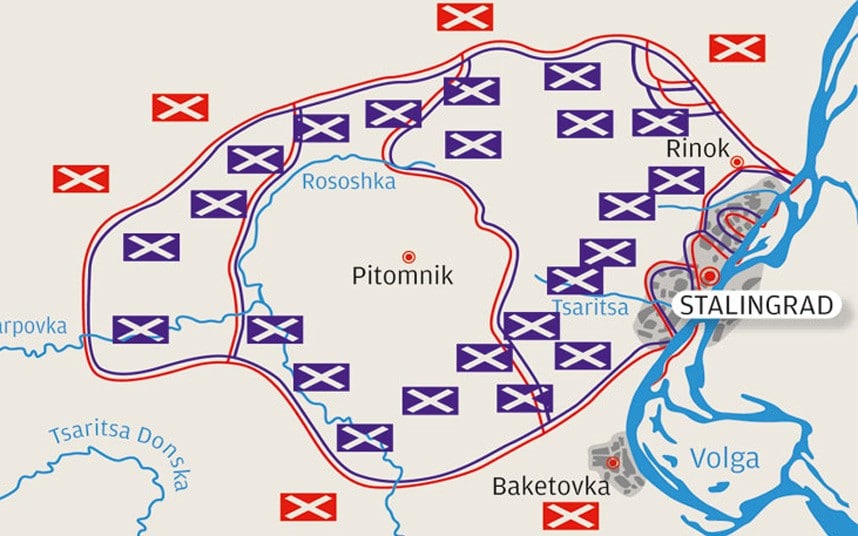
Map of Operation Ring shows the final encirclement of Axis forces
(in purple)
by the Soviet Red Army.
Operation Ring, the last part of the Battle of Stalingrad, was launched by General Rokossovsky, leading the 21st and 5th Tank Armies to finally crush the Kessel. On January 26, 1943, troops of the 21st Army linked up with troops of the 62nd Army on Mamaev Kurgan, thereby splitting the Kessel into two. The troops in the southern pocket were led by General Paulus, whereas the larger northern German pocket were led by XI Corps Commander General Strecker.
On January 31, Paulus was promoted to rank of Field Marshal by Hitler. He saw it as an offer to commit suicide, as no Field Marshal had ever been taken prisoner. He refused to commit suicide "for the Bohemian corporal." He was captured by the Russians at his headquarters and taken prisoner. He refused to order soldiers of the southern pocket to surrender, as he said he was no longer in command; however, a lot of the resistance in the southern pocket ceased January 31. On February 2, in the northern pocket, General Strecker told his officers to negotiate terms of surrender. Thereafter organized German fighting in Stalingrad ceased.
Thus ended the Battle of Stalingrad with a decisive victory for the Soviet Red Army that turned the tide of the war in favour of the Allies. The Germans did not win any major battles on the Eastern front after Stalingrad. It came at the cost of 1.1 million Red Army troops, 40,000 Russian civilian, and some 800,000 dead, wounded or missing Axis troops. Almost three million people were killed or wounded during the Battle of Stalingrad, making it the bloodiest battle in history.
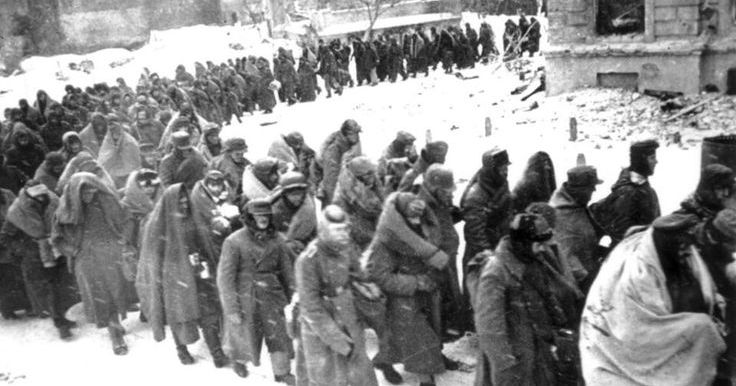
Surrendering German troops after Soviet victory in Battle of Stalingrad
in February 1943.

Soviet Red Army celebrates in Stalingrad following February 2, 1943
victory.
Reparations from Second World War
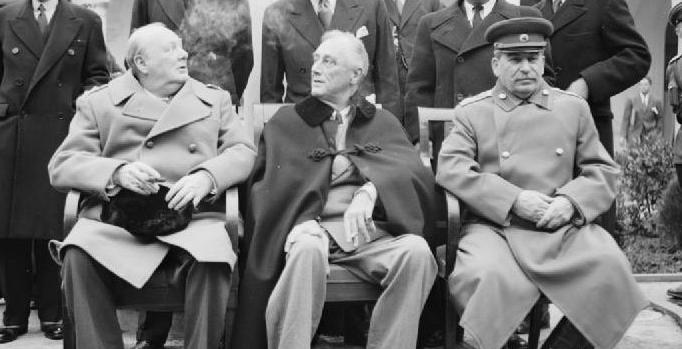
Yalta Conference, February 1945:
Winston Churchill, Franklin D. Roosevelt and Joseph Stalin.
Of all the harm inflicted on all the Allied countries (the Soviet Union, United States, Great Britain, and France) during the Second World War, approximately half occurred in the USSR.
At the Yalta Conference in February 1945, Joseph Stalin suggested that Germany pay a total of $20 billion in reparations, anticipating that half of that sum ($10 billion) would go to the Soviet Union -- the country that had made the greatest contribution to the victory and endured more than any of the other nations in the anti-Hitler coalition. With some conditions, Franklin D. Roosevelt and Winston Churchill agreed to Stalin's suggestion. Ten billion dollars is approximately what the U.S. spent on aid to the Soviet Union under the lend-lease program during the years of the Second World War. Ten billion U.S. dollars, when they were backed by gold (one dollar at that time was technically worth 1/35 troy ounce of gold), were equal to 10,000 tons of gold, so the entirety of the reparations was worth 20,000 tons of gold. In fact, the German reparations that the USSR agreed to accept would barely provide compensation for a mere 8 per cent of the direct damages inflicted upon the Soviets. And the costs of only 2.8 per cent of the total damages were recouped. This appeared to be a generous gesture on Stalin's part.
These figures stand in stark contrast to the enormous
bill for reparations
that the Entente Powers (excluding Russia) submitted to Germany at the
Paris
Conference in 1919. The Treaty of Versailles set the amount of
reparations at
269 billion gold marks -- the equivalent of approximately 100,000 (!)
tons of
gold. That nation, which had initially been battered and weakened by
the
economic crisis of the 1920s, and later by the Great Depression, was
unable
to pay the enormous sums demanded as reparations and was forced to
borrow
from other countries in order to meet the terms of the treaty. In 1921,
the
Reparations Commission reduced the amount to $132 billion, or by
approximately 50 per cent, but even that new sum was the equivalent of
50,000
tons
of gold. When Hitler took power in 1933 he put an end to the
reparations
payments altogether.
After the Second World War and the establishment of the Federal Republic of Germany in 1949, the foreign ministers of the U.S., UK, and France forced that new nation to resume payments on the debts owed under the Treaty of Versailles. In accordance with the 1953 London Debt Agreement, the German lands that had been lost after the war were permitted to forgo interest payments until after East and West Germany were reunified. The reunification of Germany on October 3, 1990 reinstated her reparations obligations under the Treaty of Versailles. Germany was given a respite of 20 years to pay off her debts, for which the country had to take out a twenty-year loan of 239.4 million marks. Only late in 2010 did Germany make her final reparations payment to her closest allies. This was very different from the Soviet Union's policy -- only a few years after the end of WWII the USSR refused reparations from Romania, Bulgaria, and Hungary, which were by then fellow members of the socialist community! Even East Germany stopped making any reparations payments to the Soviet Union shortly after that nation was established.
Stalin did not want to see a replay of what had happened in Germany and Europe after the signing of the Treaty of Versailles. It was precisely that treaty that forced Germany into a corner and set the stage for Europe's slide into the Second World War. Speaking about the peace treaty with Hungary at the Paris Peace Conference in 1947, Andrei Vyshinsky, at that time the Soviet deputy minister of foreign affairs, explained the idea behind the Soviet policy on reparations: "The Soviet government consistently follows this line in its reparations policy, which consists of starting with a realistic plan, so as not to suffocate Hungary or rip up the roots of her economic recovery, but rather to help in her economic revival, help her get back on her feet, and help her to join the common family of the United Nations and to play a role in Europe's economic revival."
The USSR also took this magnanimous approach to other countries that had fought alongside the Germans. This can be seen in the peace treaty with Italy that required the payment of $100 million in restitution to the Soviet Union, although this offset no more than 4-5 per cent of the direct damage inflicted on the USSR.
The principle behind this magnanimous approach to determining the sum of the reparations settlements complemented another important principle of Soviet policy -- that of using a country's current industrial output as the principle means of discharging the reparations debts. This principle was phrased with due regard for the lessons of the First World War. It is important to remember that the demands for reparations imposed on Germany after World War I were exclusively monetary, and to be paid in foreign currency. As a result, Germany had to focus on manufacturing products that were never intended to supply her domestic market with basic necessities, but were instead destined for export, in order to obtain the needed foreign currency. In addition, Germany was compelled to obtain loans in order to pay off each new installment of her reparations bill, which forced her into debt bondage. The Soviet Union had no desire to see that repeated. Vyacheslav Molotov explained the Soviet position at a session of the Council of Foreign Ministers on December 12, 1947: "No deliveries of reparations are currently being made from the western zones, and industry in the combined Anglo-American zone is operating at only 35 per cent of its 1938 level. Deliveries of reparations are currently being received from the Soviet zone in Germany, and industry there is operating at 52 per cent of its 1938 level. Thus, the index of industrial production in the Soviet zone -- even though a more challenging environment exists here for industrial recovery -- is 50 per cent higher than the index of industrial production in the Anglo-American zone."
At the Yalta Conference, the leaders of the USSR, USA, and Great Britain reached an agreement regarding the principle of the non-monetary nature of the reparations. The Anglo-American allies once again endorsed this at the Potsdam Conference. But in 1946 they began to work actively to scuttle this policy. In addition, they also undermined other agreements pertaining to reparations. Even at the Potsdam Conference, the allies of the USSR had agreed that Germany could partially offset her reparations debts by supplying products and dismantling equipment in the western occupation zones. However, the allies devised obstacles to prevent the Soviets from obtaining goods and equipment from the western occupation zones (only a small percentage of the planned quantities were received).
One consequence of the Cold War launched against the USSR by the West in 1946 was that no single mechanism for the allies to collect and tally reparations was ever created. And once the Federal Republic of Germany was established in the western zones of occupation in 1949, any opportunity for the Soviet Union to obtain reparations compensation from western Germany vanished forever.
After the Yalta Conference, the precise total of the reparations imposed on Germany after the Second World War was never again cited. And that issue remains fairly opaque. The full sum of Germany's reparations debts was not documented. An effective mechanism was never created for the centralized collection and tallying of Germany's reparations payments. The victorious countries satisfied their reparations claims against Germany unilaterally.
Judging by statements from her officials, not even Germany herself knows exactly how much she has paid in reparations. The Soviet Union preferred not to receive reparations in cash, but in kind. According to Russian historian Mikhail Semiryaga, for one year beginning in March 1945, the highest bodies of power in the Soviet Union made almost a thousand decisions related to the dismantling of 4,389 companies from Germany, Austria, Hungary, and other European countries. In addition, approximately one thousand factories were moved to the USSR from Manchuria and even Korea. These are impressive figures. But that depends what you compare them to. The Nazi invaders razed 32,000 industrial plants in the USSR. That means that the number of manufacturing facilities dismantled by the Soviet Union in Germany, Austria, and Hungary represented merely 14 per cent of what was destroyed in the USSR. According to Nikolai Voznesensky, who was at that time the chairman of the Soviet Union's Gosplan Committee, the value of the equipment taken as spoils from Germany compensated the Soviet Union for only 0.6 per cent of the direct damage she suffered.
Some data can be found in German documents. Thus, according to information from the West German Ministry of Finance and the Federal Ministry of Intra-German Relations, all that was confiscated from the Soviet occupation zone and the German Democratic Republic prior to 1953 was worth 66.4 billion marks, or 15.8 billion dollars. German experts claim this is equivalent to $400 billion in today's dollars. Confiscations were made both in kind as well as in cash. The reparations that passed from Germany to the USSR primarily consisted of the following: goods currently being manufactured by German firms -- 34.70 billion marks, and cash payments in various currencies (including occupation Reichsmarks) -- 15.0 billion marks.
Between 1945 and 1946 a common form of reparations consisted of dismantled equipment from German companies that was sent to the USSR. In March 1945 a Special Committee of the Soviet State Defence Committee was created in Moscow, which coordinated all the work to dismantle German military-industrial facilities in the Soviet zone of occupation. Between March 1945 and March 1946, decisions were made to dismantle more than 4,000 industrial plants: 2,885 from Germany, 1,137 from German companies in Poland, 206 from Austria, 11 from Hungary, and 54 from Czechoslovakia. The key equipment was dismantled at 3,474 sites, and 1,118 million pieces of equipment were confiscated, including: 339,000 metal-cutting tools, 44,000 presses and sledgehammers, and 202,000 electric motors. Sixty-seven factories that manufactured only military goods were dismantled in the Soviet zone, 170 were destroyed, and eight were converted to civilian production.
However, once this equipment was dismantled, manufacturing came to a halt in eastern Germany and unemployment surged, so by early 1947 the Soviets began to limit reparations of this type. Instead, 31 joint-stock companies created with Soviet entities were established, based on 119 large firms in the eastern occupation zone. In 1950, these were responsible for 22 per cent of the German Democratic Republic's (GDR's) industrial output. In 1954, all joint-stock companies created with Soviet entities were freely transferred to the GRD. This represented the final word in that chapter from the history of WWII reparations.
(Strategic Culture Foundation, May 7, 2015. Slightly edited for grammar and style by TML.)
British Betrayal of Its Own Convoys Carrying
Supplies to Help the Soviets
The following is
excerpted from the book Proxy Wars (St. Petersburg, 2017) by Russian
historian, writer and political activist Nikolay Starikov.
Part I
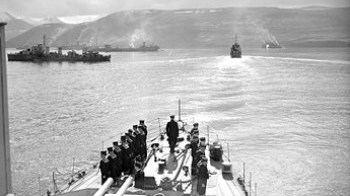
Photo of PQ 17 convoy in Iceland in May 1942, before it sailed.
The disaster that befell Great Britain's legendary PQ 17 convoy, which was carrying military aid to the Soviet Union in July 1942, remains a mystery only to those who do not understand London's true agenda during World War II.
The second front, which the Allies had promised Moscow in 1941, was not opened either in that year or the next. After all of Stalin's diplomatic efforts and battles, assistance to the USSR came in the form of military supplies. The simplest and most efficient way to deliver that cargo was by sea. Polar convoys were assembled in Iceland and then sailed around Scandinavia to wind their way to Murmansk or Arkhangelsk. Each of them was guarded by British warships. The Germans attacked the polar convoys from airfields inside Nazi-occupied Norway. German submarines and surface vessels were based there, at military installations in Narvik and Trondheim.
Before July 1942 the convoys had experienced few
casualties -- the first occurred when convoy PQ 12 (March 1942,
consisting of 12 merchant ships) lost one vessel and one
destroyer escort. PQ 13 lost four vessels, PQ 14 -- one
vessel, PQ 15 -- three vessels, and PQ 16 -- seven
merchant ships.
But out of the 34 merchant ships and tankers
in the PQ 17 convoy, which set sail out of Hvalfjörður
fjord on June 27, 1942, only 13 made it to the shores of the
Soviet Union -- 21 vessels were sunk! Out of the 297
airplanes included in that cargo, 210 went to the bottom of the
sea, as did 430 of the 584 tanks, 3,530 of the 4,246 automobiles
that were secured to the decks and stored in the holds, plus so
much other military cargo that was so badly needed by the USSR,
which was embroiled in fierce, heavy fighting on the Don and
Volga. In all, 122,000 tons of cargo were lost out of the
original total of 188,000 tons, in addition to the hundreds of
human deaths ...

But it was not these enormous losses that gave the PQ 17 convoy its own page in the history books -- it was because of the reason why they happened. This reason had a human face. The fact is, the British warships ... simply abandoned the convoy to the mercies of fate. They sailed away, ordering the convoy to scatter and for all its ships to make their own way to Soviet shores. Afterward, those defenseless vessels were easy prey for German submarines and aircraft ...
The convoy's military escort and covering forces consisted of six destroyers, four corvettes, four armed trawlers, three minesweepers, two submarines, and two anti-aircraft auxiliaries. Commander Jack Broome was in charge of the expedition and would later publish quite a remarkable memoir, Convoy Is to Scatter.
On July 3, 1942, after successfully fending off several German air attacks, the flagship of the escort received a coded cable from London, claiming that "photographs of Trondheim show that [German battleships] Tirpitz, Hipper, and 4 destroyers have left."
On July 4, 1942, there were renewed German air attacks on the convoy. This time the Germans had much better luck: two ships were sunk and three damaged, but the Luftwaffe lost six planes. And then "something strange" happened. Early in the morning of July 5, Rear Admiral Hamilton gave his First Cruiser Squadron orders to retreat, withdrawing its protection from the convoy, and Admiral Pound, the Admiral of the Fleet, commanded the merchant ships to "scatter." This decision was based on information that had allegedly been received regarding a threat of attack on the convoy from the battleship Tirpitz. It would be an understatement to say that Commander Jack Broome found this order to be utterly baffling and bewildering:
The best descriptive parallel I could think of was an electric shock. The order to SCATTER is the prerogative of the senior man on the spot when, and only when, an overwhelming force attacks his convoy, which would be more difficult to massacre spread out than if it remained concentrated. It is the last straw, the ‘sauve qui peut' and it is, of course, irrevocable ... Upon obtaining these messages, separated by an interval of only 13 minutes and arriving with increasing urgency, we could draw only one conclusion. The Admiralty had received confirmation that the Germans were ready to strike, and these confirmations were sufficiently reliable for them to decide that, in the event of unrelenting attacks from above and below, defenseless merchant vessels would thus be safer than they would in the convoy ... PQ 17 was the first convoy in the history of the Royal Navy to be ordered to scatter by an officer who was not on the spot.
|
|
The official British story insists that the PQ 17 convoy was the victim of a tragic mistake. Supposedly, as soon as Lord Pound made his fateful decision and saw it through, it emerged that the German squadron had not gone anywhere and was still at its base in Norway!
But what really happened? Immediately after the treaty of alliance was signed with the USSR on May 26, 1942, British leaders, most likely Churchill himself, issued a secret order that the next convoy must not make it to the shores of the Soviet Union. All of Admiral Pound's later actions, which are without parallel in naval and military history, are nothing more than his efforts to carry out the instructions he had been given. This not only made it possible to "help without helping" the Red Army, but also gave the British leadership a free hand to do their best to end the convoys altogether, on the pretext of having suffered "huge casualties." This was a cutoff of assistance to the Soviet Union, right at a critical moment during the Battle of Stalingrad. What's more, because the British practically surrendered the convoy and handed over their sea route to the Nazis by withdrawing the protecting warships, this amounted to directly abetting Hitler's continued surge toward Stalingrad to finish off Soviet Russia. In order for the Führer to be made to see that his only way out was to crush the USSR, or in other words, to escalate the war, he needed irrefutable evidence that the British were prepared to betray Russia. And although they were officially allies, the British would be ready to make peace with the Reich if the USSR could be defeated. The British betrayal of their own convoy was proof offered to the Germans that this time a deal with them was possible.
The Germans really did know the names of each of the ships in the convoy and even the cargo each carried! The German submariners had no reason to hide. They surfaced and, not wasting their torpedoes, easily sank the defenseless merchant ships with artillery fire. The rescued Allied sailors later claimed that the Nazis were surprisingly well informed as to what each vessel was carrying. To explain this astonishing fact, the British later circulated the information that the Germans had allegedly found the code books and ship list aboard the merchant ship the SS Paulus Potter, which had been left adrift after having fallen under attack (the crew had abandoned the vessel but never scuttled it). Another oddity in the Germans' behavior that was noticed by the eyewitnesses was their surprising nonchalance and confident sense of impunity. They did not seem to be fighting as much as ... enjoying themselves, on a pleasant, innocent outing:
They were virtually handed a licence to bomb, torpedo, and photograph us, then shoot off home to photograph themselves putting on their medals! ... Seldom can so much film footage have been taken of a single action at sea, all from an enemy standpoint, which reaped such a rich harvest in propaganda. (Paul Lund, PQ 17: Convoy to Hell)
One more curious detail: the radio cable ordering the convoy to retreat was sent by the British "in the clear," in other words, without encryption! There is to this day still no rational explanation for why every basic rule of secrecy was suddenly violated. The only logical reason for sending a crucially important radio message in the clear when there was no pressing need to do so (!) would be that there was a desire for it to be immediately read by the enemy. The British openly informed the Germans that the convoy was now defenseless and could be easily attacked, but that there was no need to strike at the retreating cruisers and ships from the convoy that could fend for themselves. From that perspective it is immediately clear why the Germans behaved with such nonchalance and were so utterly confident of their impunity.
Another important fact: on July 5, 1942, the British
warships
received yet another radio cable, the meaning of which is
difficult to interpret as anything other than a desire to cover
their tracks:
Please note that the
Admiralty's message ...
to the ships escorting the PQ 17, to the commander of the 1st
Cruiser Squadron and the Commander-in-Chief of the Home Fleet
ordering the convoy to scatter was transmitted in naval
encryption, and not in the clear, as was noted on the copies in
circulation." (Jack Broome, Convoy
Is to Scatter).
In other words, the ship captains were asked to forge an entry in their ship's log and to note that the telegraphed order "convoy is to scatter" was sent in encrypted form, rather than in the clear, as it actually was! Later, the Admiralty decided to destroy all the radio transmission logs from that campaign.
Is it not surprising that, after learning of the tragedy of convoy PQ 17, Stalin asked, "Do British naval officers even understand the concept of honour?"
Part II
On July 28, 1942 Stalin issued his famous order no. 227: "Not one step back!" And this was not because he had forgotten to do it in 1941, but because the state of affairs on the front lines of the war had become much more dangerous and the prospect of a Soviet military defeat seemed far more possible than it had at the beginning of the war. That is why on Oct. 19, 1942, Stalin wrote to the Soviet ambassador in England, Ivan Maisky:
All of us in Moscow have gained the impression that Churchill is aiming at the defeat of the USSR, in order to then come to terms with the Germany of Hitler or Brüning at the expense of our country. Otherwise it is difficult to explain Churchill's behavior either in regard to the second front in Europe or the arms shipments to the USSR, which continue to dwindle.
The PQ 17 tragedy occurred in early July 1942, and Stalin's telegram was sent in mid-October. In the interval Churchill had sent letters of "explanation," the British had attempted to scale back the convoys, and Churchill had visited Moscow from August 12-14. As a result -- Stalin became convinced, as he expressed in his telegram to Maisky, that Churchill was conspiring with Hitler.
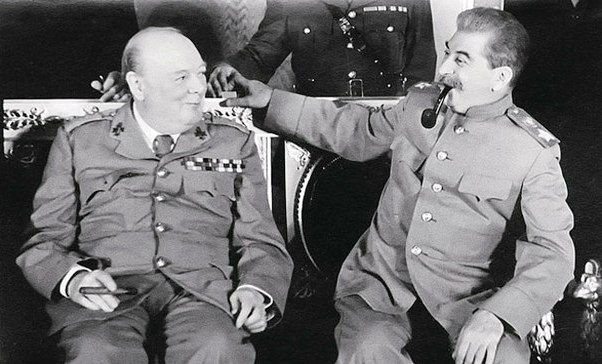
Winston Churchill and
Joseph Stalin at the Kremlin in August 1942.[1]
You can judge for yourself the feebleness of Sir Winston's "explanations" about the PQ 17 tragedy by reading the correspondence of the two leaders in its entirety, so we'll just offer the highlights here. The British prime minister's entire letter to Stalin on July 18, 1942 can be boiled down to one sentence: we cannot fight the Germans, because it will cost us dearly. And therefore, writes Sir Winston, we have no choice but to end the convoys to the USSR. Stalin's letter of response on July 23, 1942 sheds a clarifying light on what was happening at that time:
I have received your message
of July 18. I gather
from
the message, first, that the British Government refuses to go on
supplying the Soviet Union with war materials by the northern
route and, secondly, that despite the agreed Anglo-Soviet
Communique 20 on the adoption of urgent measures to open a second
front in 1942, the British Government is putting off the
operation till 1943. According to our naval experts, the
arguments of British naval experts on the necessity of stopping
delivery of war supplies to the northern harbours of the U.S.S.R.
are untenable. They are convinced that, given goodwill and
readiness to honour obligations, steady deliveries could be
effected, with heavy loss to the Germans. The British Admiralty's
order to the P.Q. 17 convoy to abandon the supply ships and
return to Britain, and to the supply ships to disperse and make
for Soviet harbours singly, without escort, is, in the view of
our experts, puzzling and inexplicable. Of course, I do not think
steady deliveries to northern Soviet ports are possible without
risk or loss. But then no major task can be carried out in
wartime without risk or losses. You know, of course, that the
Soviet Union is suffering far greater losses. Be that as it may,
I never imagined that the British Government would deny us
delivery of war materials precisely now, when the Soviet Union is
badly in need of them in view of the grave situation on the
Soviet-German front. It should be obvious that deliveries via
Persian ports can in no way make up for the loss in the event of
deliveries via the northern route being discontinued. As
to the second point, namely, that of opening a second front in
Europe, I fear the matter is taking an improper turn. In view of
the situation on the Soviet-German front, I state most
emphatically that the Soviet Government cannot tolerate the
second front in Europe being postponed till 1943. I hope you will
not take it amiss that I have seen fit to give you my frank and
honest opinion and that of my colleagues on the points raised in
your message.
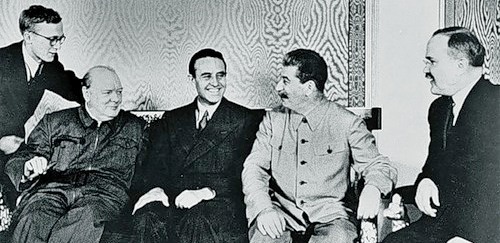
Moscow Conference, August 1942: Winston Churchill, U.S. Ambassador
Averell Harriman,
Joseph Stalin, Soviet Foreign Minister
Vyacheslav Molotov.
During Churchill's visit to Moscow a few days later, Stalin would tell him quite pointedly, "The Germans do not have a large fleet, and it needs to be destroyed, rather than scattering the convoys." Stalin knew who he was dealing with. He knew who had raised Hitler to power and the reason for that. He understood that England's ultimate goal was to drag out the Soviet-German war for as long as possible. This was why he was so affronted by the excuse of these "circumstantial factors" that his "allies" were forced to send the PQ 18 convoy to the USSR in early September 1942. Interestingly enough, the military escort ships accompanying the PQ 18 convoy were also ordered to focus on protecting themselves, rather than the supply vessels. (Paul Lund, PQ17: Convoy to Hell ). But this time that order was ignored, and the British sailors successfully safeguarded the transports. The fact that the PQ 17 could have been protected is also evident from the fact that despite a fierce battle in the Barents Sea north of North Cape, 28 out of 41 vessels of the PQ 18 arrived safely in Soviet port, causing a dramatic loss to Luftwaffe (around 40 aircrafts piloted by the best German aces were hit by the escort during the voyage).
The history of the PQ 17 is only a small fragment in the mosaic of the elaborate games that the British establishment employed during the Second World War to achieve its elusive goals. To that end they sacrificed their own citizens and soldiers. For example, as part of the Operation Fortitude campaign of disinformation in the first half of 1944, British intelligence sent agents into various countries of occupied Europe who, for one reason or another, "knew" the place and time of the Allied landing in Europe. According to the information they provided, that landing was to occur in Pas-de-Calais. The directors of the operation also saw to it that these agents fell into the hands of the Gestapo and that the poison capsules they were given to use in the event of their arrest turned out to be worthless. But the evidence of those suicide attempts would make the information that the Gestapo obtained by torturing the captured agents seem more reliable. As a result, the credulous Germans were awaiting the Allied landing in entirely the wrong place. Moreover, after Allied troops stormed the beaches at Normandy, Hitler, who was expecting a landing in Pas-de-Calais, failed to move several tank divisions south that would have been capable of repelling that invasion.
And what about those unfortunate agents? Some of them survived the war, and, realizing what had happened to them, demanded an investigation. But, like the logs of the arctic-convoy radio cables, the archive of the Special Operations Executive had been destroyed just in time. In response to attempts to discover what really happened, the British government has donned an expression of affronted dignity. They claim that such a course of action would have been beneath them and they are outraged by the very suggestion.
No documents exist. That means it never happened
...

TML Note
1. It was after that meeting in August 1942 that
Churchill, in a speech to the British House of Commons on
September 8, 1942, had the following to say about Joseph Stalin:
It was an experience of great interest to me to meet Premier Stalin ... It is very fortunate for Russia in her agony to have this great rugged war chief at her head. He is a man of massive outstanding personality, suited to the sombre and stormy times in which his life has been cast; a man of inexhaustible courage and will-power and a man direct and even blunt in speech, which, having been brought up in the House of Commons, I do not mind at all, especially when I have something to say of my own. Above all, he is a man with that saving sense of humour which is of high importance to all men and all nations, but particularly to great men and great nations. Stalin also left upon me the impression of a deep, cool wisdom and a complete absence of illusions of any kind. I believe I made him feel that we were good and faithful comrades in this war -- but that, after all, is a matter which deeds not words will prove.
(Adapted and translated by Oriental Review, October 24, 2017.)
Website: www.cpcml.ca Email: editor@cpcml.ca
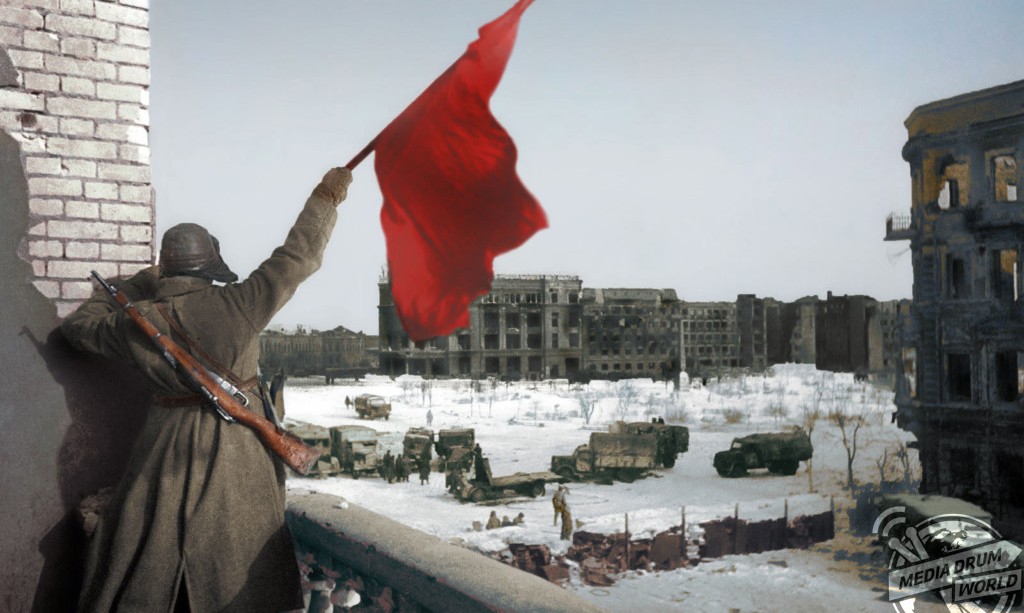


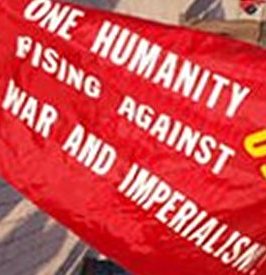


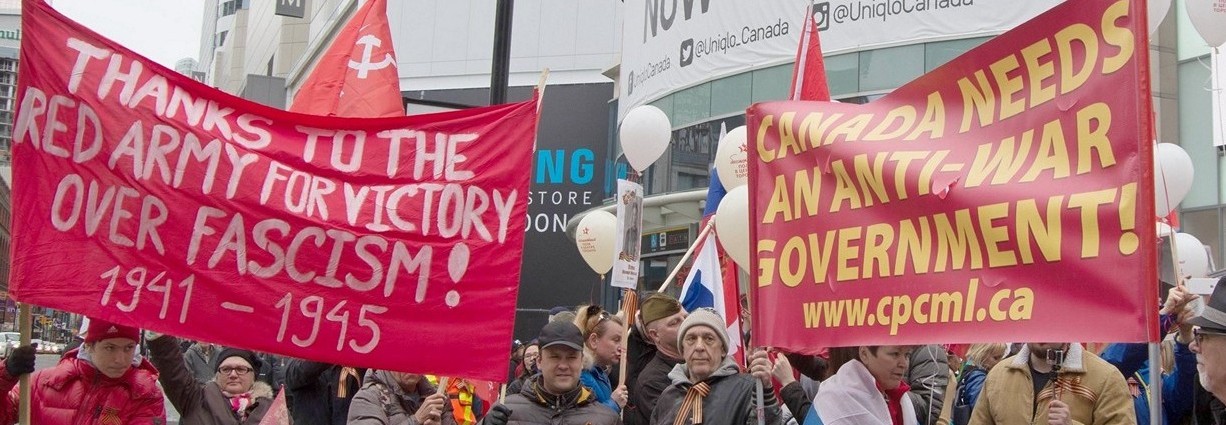
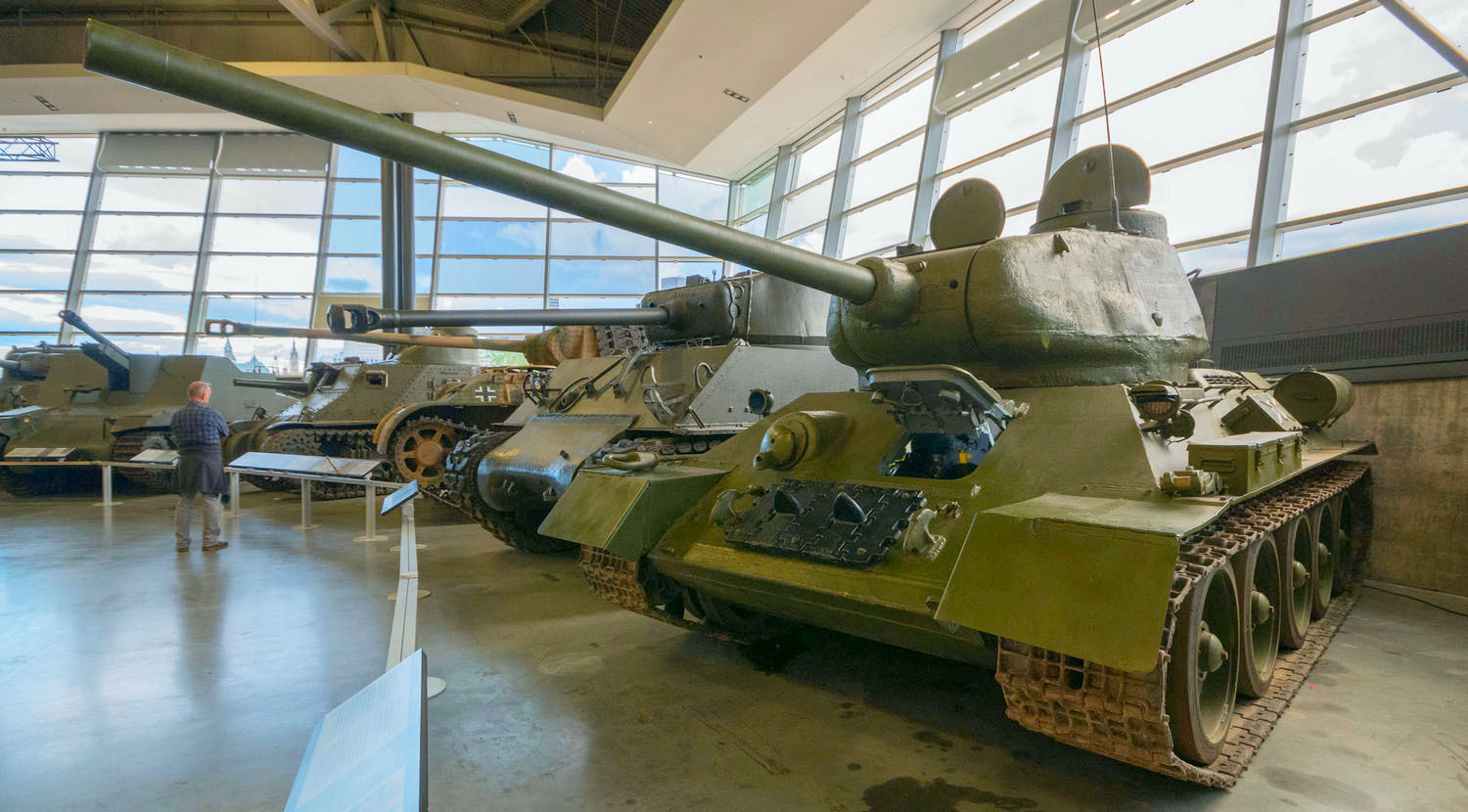
 Today, a complex, dangerous
and difficult situation exists
that requires its own analysis and actions with analysis. This
need cannot be supplanted by imposing scenarios from the past
onto the present. Today, peoples' fronts against war are also
necessary in the form of anti-war governments built on a new
historical basis, consistent with the needs of the times.
Anti-war governments must enable the people to make themselves
part of the equation in a manner that permits all of humanity to
turn things around in their favour.
Today, a complex, dangerous
and difficult situation exists
that requires its own analysis and actions with analysis. This
need cannot be supplanted by imposing scenarios from the past
onto the present. Today, peoples' fronts against war are also
necessary in the form of anti-war governments built on a new
historical basis, consistent with the needs of the times.
Anti-war governments must enable the people to make themselves
part of the equation in a manner that permits all of humanity to
turn things around in their favour.